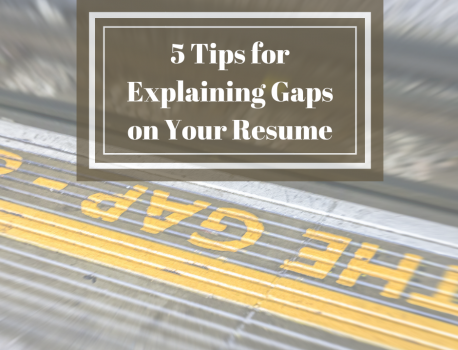How do you present your best self on a resume? How do you demonstrate that you are the best fit for the role in just a couple of pages?
I am excited to have Dr. Heather Rothbauer-Wanish, a Certified Professional Resume Writer, who has been partnering with thousands of clients since 2008 to develop dynamic and targeted resumes present the Top 10 Resume Tips for Today’s Workplace in a webinar next week. As a preview, she has kindly provided us with the below 5 Tips for Explaining Gaps on Your Resume.
It happens to everyone at one point in a career or work history. You move to a different state, struggle after your company closes, take time off to care for an ailing parent, or take a maternity leave after welcoming a child. While all of these things happen for various reasons, they also sometimes make writing an updated resume even more difficult. Here are five tips on how to address these gaps.
Tip #1 – Be honest.
Do NOT try to hide gaps or pretend that a two-year leave is not a big deal. If an employer sees that and there is no explanation as to what you were doing during that time, it immediately raises a red flag about your dedication and past work history.
Tip #2 – Don’t include all details.
Just because your father is 85 years-old and you have taken time to care for him, you don’t need to include all of the information. Instead, say something simple such as, “Spent 2017 – 2018 caring for an ailing family member.” You do NOT need to provide a synopsis of your personal life.
Tip #3 – Short terms at companies should be explained.
If you had bad luck and worked at ABC Company for three months and then they laid off the newest employees, say that. Otherwise, it looks like you may be a job-hopper who doesn’t dedicate himself or herself to the workplace. For example, the following information would explain this situation, “ABC Company laid off 20% of its current workforce during September 2018.”
Tip #4 – Educational leaves can be addressed.
If you took two years ‘off’ from full-time work to complete a college degree, then state it. An example may be, “During 2016 – 2018, took time away from full-time positions to focus on completion of Bachelor of Science in Marketing.” Then, you can list your education on your document and also address the possible gap in work history.
Tip #5 – You are NOT alone.
Most people think their particular gaps in employment look terrible. The truth is, everyone has some sort of work history that may not be ideal. The important thing is that you recognize it and know that a gap doesn’t automatically eliminate you from consideration.
Thank you Dr. Heather for sharing your expertise with us! Looking forward to hearing more from you on October 2!

